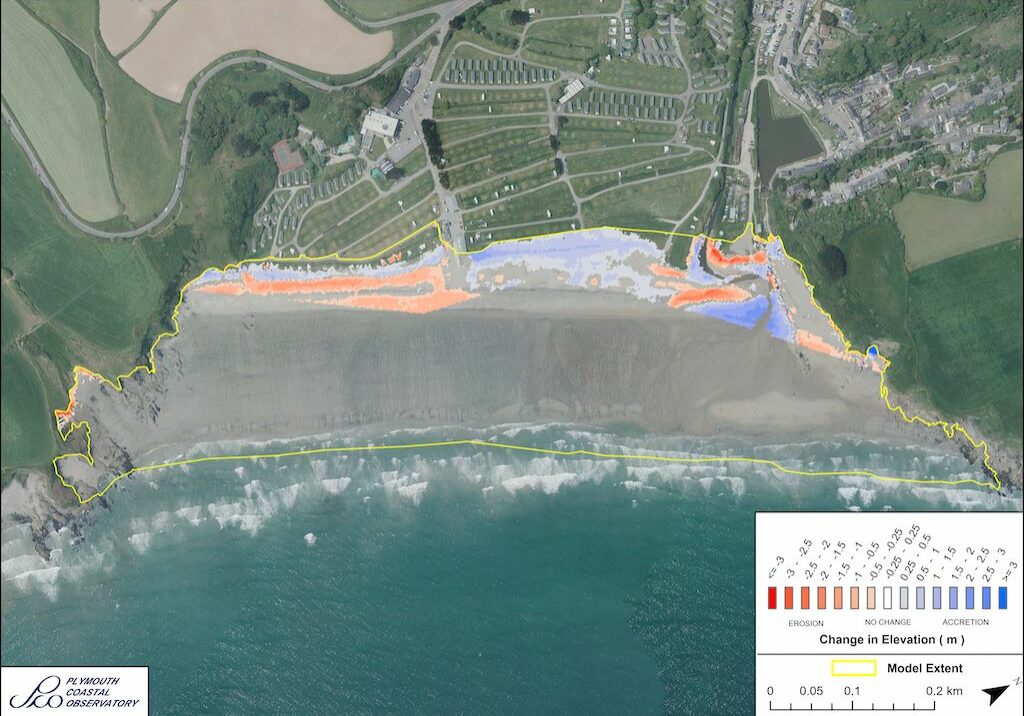
Pentewan (Cornish: Pentewyn, meaning ‘foot of the sandy dune or beach’) is a wide south-east facing beach, within Mevagissey Bay, on the south coast of Cornwall.
Two watercourses flow onto the beach, to the north-west flows the Pentewan Stream and to the north-east St Austell River. The catchment for the stream is relatively short, especially compared with that of St Austell River, which stretches several kilometres inland through clay country, towns, villages and steep sided wooded valley’s.
Pentewan is a wide sandy beach fringed by high vegetated cliffs. The village of Pentewan has developed around the former port located on the northern side of the beach, which in its heyday, overshadowed nearby Mevagissey in importance. The area to the south of the beach, which is now a holiday park, was formally called Winnick, Cornish for marsh. This indicates how, over time, sediments have built up in the area. The holiday park is separated from the beach by a natural sandy ridge, which has been reinforced in places to protect the space behind it.


Coastal Change
The coastline of Cornwall is an ever-changing environment. It is energetic, dynamic, never still and changes with each wave and each tidal cycle. Some of the changes we see are gradual and barely noticeable, whilst others, such as rockfalls, happen suddenly and often shockingly.
From one visit to the next it can sometimes be difficult to see how a beach and dune system has changed, but information has been collected, and is being collected through the Making Space for Sand project, to help us better understand how the coastline is changing. The purpose of this section of the website is to understand each location has changed over time, how it could change in the future and understand the policies that influence how we can respond to these changes.
Shoreline Management Plans (SMP)
The Shoreline Management Plan (SMP) is a strategic planning and management assessment tool that helps identify and measure the risk associated coastal erosion and coastal flooding. The document makes a number of policy recommendations over short, medium and long term timeframes setting out a strategic approach to managing the built, natural and historic environments associated with the coastline. Within SMP there are four policy approaches which have been assigned to stretches of coastlines. The four policies are: No Active Intervention (NAI), Hold the Line (HTL), Managed realignment (MR), and Advance the line (ATL).
Pentewan sits within Policy Development Zone 4 (PDZ4), in Management Area 8 (MA8), within Policy Units (PU) 8.2 and 8.3. The policy recommendations for these policy units are detailed in the table below:
The SMP can be accessed through the Cornwall Council website using this link below:
Use your touchscreen
to scroll the below table
| Policy Unit | Policy Plan | ||||
| 2025 | 2055 | 2105 | Comment | ||
| 8.1 | Undefended cliffs
Main Policy Sub Policy
|
NAI DnD |
NAI DnD |
NAI DnD |
Continue with existing approach. Allow natural coastal evolution to occur to support conservation interest of protected sites. |
| 8.2 | Pentewan Harbour & village
Main Policy Sub Policy
|
MR NF |
MR NF |
HTL NF |
Policy to provide more flexibility to address flood risk and facilitate local re-development. With consideration of local objectives for flood risk management and regeneration, investigate realignment options that would allow transition of the beach to a more sustainable position that could be maintained to at least the lifetime of the SMP. |
| 8.3 | Pentewan Beach
Main Policy
Sub Policy
|
NAI
LAO |
MR
NF |
NAI/ HTL LAO
|
Allow beach to respond naturally to sea level rise. Avoid constraining and reducing beach and dune width. Guide land use planning towards a roll back policy through a Managed Realignment approach, with consideration of implications for sustainable highway links in the area and ongoing local activity to manage the shoreline where required.
|
| Key Main Policy: HTL - Hold the Line, A - Advance the Line, NAI – No Active Intervention, MR – Managed Realignment
Sub Policy: DnD – Do not Defend, NF – Natural Features, LAO – Local Activity Only |
|||||


National Coastal Erosion Risk Mapping (NCERM)
National Coastal Erosion Risk Mapping (NCERM) provides a baseline of coastal erosion, for the coastline of England, over short, medium and long-term timeframes. The data is based on the natural and defence characteristics of the coastline and provides rates of erosion at differing levels of confidence to help better plan for worse case scenarios. The data provided is for guidance and does not estimate the absolute location of the future coastline.
The basic NCERM lines show erosion estimates for the Short Term (ST-20 years), Medium Term (MT-50 years) and Long Term (LT- 100 years). The data is further categorised by probability: 05 is 5% probability (a 1 in 20 chance of being exceeded) Red Shading, 50 is 50% probability of being exceeded (a 1 in 2 chance of being either exceeded or not exceeded) Orange Shading and 95 is 95% probability (a 19 in 20 chance of being exceeded) Yellow Shading. Click the link below to access the Cornwall Council NCERM Mapping site read the about section then click on layers.
Historical Images of Pentewan
Historical photographs provide a powerful insight into how the Cornish coastline has changed within the past Century. The Making Space for Sand project are working in collaboration with the Francis Frith collection and have been given permission to share historical images on a number of beaches considered within the project.
In looking back, we can better understand how the coastline has changed, helping us understand not only how the coastal fringe has developed but also the potential future changes that we my observe. When this is considered alongside forecasts of coastal erosion and sea level rise it will help enable us to better adapt to our changing coastline.
Pentewan from Penare Cliffs, c1955 (Image courtesy of the Francis Frith collection) and in 2024
Pentewan from Penare Cliffs in 1931 (Image courtesy of the Francis Frith collection) and in 2024
Pentewan from Gama Point in c1955 (Image courtesy of the Francis Frith collection) and in 2024

Modelling Coastal Change

Using data that has already been collected, combined with data collected through the Making Space for Sand project, a series of models will be carried out at each location. This will help us better understand how each location may respond to sea level rise and gain a deeper understanding of how coastal sediments move and behave.
The complexity of the modelling, and the data collection that helps inform it, means that modelling outputs will not be the same on all sites. Some locations will be more thoroughly investigated to understand more complex issues and provide data that can be more widely applied to other sites with similar characteristics.
As the project develops this section of the website will expand, sharing new reports and coastal change projections when they are produced.
LiDAR surveys, which are explained on the Data Modelling page, have been carried out by the South West Coastal Monitoring program at this location. The image shared here visualises where sand has eroded (areas shaded in red) and where it has built up (areas shaded in blue), between the LiDAR surveys carried out in 1998 and 2020. The darker the shade of red or blue the greater the amount of sand erosion or accumulation has been observed. The image helps visualise that beaches are areas that change shape over time and will continue to do so as sea levels rise.


Designations
The coastline represents an important transition between the marine environment and the terrestrial environment. This transition creates a range of special habitats and exposes a range of interesting features, which that can result in these spaces being highly designated and protected. There are a range of designations that recognise a variety of different features. At this location these designations are explored below.
Special Protected Area (SPA)
A Special Protection Area (SPA) are areas of international importance for the breeding, feeding, wintering and migration of rare, threatened or vulnerable bird species.
The Falmouth Bay to St Austell Bay SPA covers the area of 258,98 hectares, below mean high water (MHW),between Nare Point and Gribben Head. The area qualifies for designation as it is regularly used by Annex I listed species including the Black-throated diver, the Great northern diver and the Slavonian grebe.
Designate Cornwall National Landscape Area
From November 2023, all areas previously know as Areas of Outstanding Natural Beauty, or AONBs, were re-named National Landscape and in Cornwall became Cornwall National Landscape. However, the Management Plan still references the term AONB as this was formally adopted by Cornwall Council and cannot be amended until the next plan is produced.
Cornwall National Landscape areas are protected and have distinctive character and natural beauty which is so outstanding that its in the nation’s interest to safeguard them. As such they have been nationally designated by the same legislation as National Parks and have the same status and level of protection.
Image of the Portscatho coastline (Courtesy of Annette Anderson)
The South Coast Central section of Cornwall National Landscape
The South Coast Central section covers an area of 15,993 hectares, which is 16.6% of the total Cornwall National Landscape area. The key landscape characteristic is a ridge which separates the Roseland from the Carrick Roads, consisting of a narrow strip of land barely half a kilometre wide between Zone Point and Gerrans Bay, broadens to include a stretch of varied and scenic coastland around Veryan Bay.
Image of birds taking flight at Pentewan (Courtesy of Graham Walker)
Sign up to Making Space for Sand
If you would like to get involved in helping to make dunes more resilient and biodiverse, want to help develop coastal adaptation and emergency plans or just want to know more about what the project is learning about coastal change, please click here:








